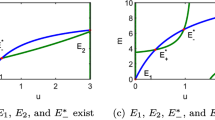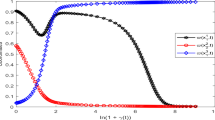Abstract
In this paper the evolution of bargaining behavior is studied under the assumption that individuals might choose between obstinate and responsive strategies. Following Ellingson (1997) it is assumed that obstinate agents commit to a certain demand, whereas responsive agents adapt optimally to their opponents strategy. Agents change strategies due to imitation based on observations of the success of other individuals. An agent-based model, where the updating of the population profile is governed by tournament selection and mutation, is used to describe the evolution of behavior. In contrast to existing local and stochastic stability results, which predict robust convergence to an equal split norm in this and related frameworks, the simulations show persistent episodes of substantial deviation of behavior from the equal split. Furthermore, it is shown that parameters governing frequency and type of updating as well as selection pressure have significant impact on the qualitative features of the simulation results. This shows the importance of being able to attach economic interpretations to changes in these parameter values.
Similar content being viewed by others
References
Arifovic, J. and Ledyard, J. (2005). Computer Testbeds for Mechanism Design, Working Paper, Simon Fraser University.
Binmore, K., Samuelson, L. and Young, P. (2003). Equilibrium selection in bargaining models. Games and Economic Behavior, 45, 296–328.
Borgers, T. and Sarin, R. (1997). Learning through reinforcement and replicator dynamics. Journal of Economic Theory, 77, 1–14.
Carpenter, J.P. (2002). Evolutionary models of bargaining: Comparing agent-based computational and analytical approaches to understanding convention evolution. Computational Economics, 19, 25–49.
Dawid, H. (1999). On the convergence of genetic learning in a double auction market. Journal of Economic Dynamics and Control, 23, 1545–1567.
Dawid, H. and MacLeod, W.B. (2001). Holdup and the evolution of bargaining conventions. European Journal of Economics and Social Systems, 15(3), 153–169.
Dawid, H. and MacLeod, W.B. (2004). Hold-up and the Evolution of Investment and Bargaining Norms, Working Paper, University of Bielefeld.
Ellingsen, T. (1997). The evolution of bargaining behavior. Quarterly Journal of Economics, 112, 581–602.
Ellingsen, T. and Robles, J. (2002). Does evolution solve the hold-up problem? Games and Economic Behavior, 39, 28–53.
Gerding, E.H., van Bragt, D.D.B. and La Poutre, J.A. (2000). Scientific Approaches and Techniques for Negotiation: A Game Theoretic and Artificial Intelligence Perspective, CWI Report SEN-R0005.
Gerding, E.H., van Bragt, D.D.B. and La Poutre, J.A. (2003). Multi-issue negotiation processes by evolutionary simulation, validation and social extension. Computational Economics, 22, 39–63.
Hofbauer, J. and Sigmund, K. (1998). Evolutionary Games and Population Dynamics, Cambridge University Press, Cambridge, UK.
Hurwicz, L. (1994). Economic design, adjustment processes, mechanisms and institutions, Economic Design, 1, 1–14.
March, J. G. (1991). Exploration and exploitation in organizational learning. Organization Science, 2, 71–87.
Marks, R. (2006). Market Design using Agent-Based Models. Forthcoming in L. Tesfatsion and K. Judd (eds.), Handbook of Computational Economics Vol. 2: Agent-Based Computational Economics, North-Holland. pp. 1339–1380.
Nash, J.F. (1950). The bargaining problem. Econometrica, 18, 155–162.
Nash, J.F. (1953). Two-person cooperative games. Econometrica, 21, 128–140.
Nowak, M.A. and Sigmund, K. (1992). Tit for tat in heterogenous populations. Nature, 355, 250–253.
Nowak, M.A. and Sigmund, K. (1995). Invasion dynamics of the finitely repeated prisoner's dilemma. Games and Economic Behavior, 11, 364–390.
Oliver, J.R. (1996). A machine learning approach to automated negotiation and prospects for electronic commerce. Journal of Management Information Systems, 13, 83–112.
Rubinstein, A. (1982). Perfect equilibrium in a bargaining game. Econometrica, 50, 97–109.
Saez-Marti, M. and Weibull, J.W. (1999). Clever agents in young's evolutionary bargaining model. Journal of Economic Theory, 86, 268–279.
Sandholm (2002). Evolutionary implementation and congestion pricing, Review of Economic Studies, 69, 667–689.
Srinivas, M. and Patnaik, L.M. (1994). Adaptive probabilities of crossover and mutation in genetic algorithms. IEEE Transactions on Systems, Man and Cybernetics, 24, 656–667.
Trö ger, T. (2002). Why sunk costs matter for bargaining outcomes: An evolutionary approach. Journal of Evolutionary Theory, 102, 375–402.
van Bragt, D., van Kemenade, C. and La Poutre, H. (2001). The influence of evolutionary selection schemes on the interated prisoner's dilemma. Computational Economics, 17, 253–263.
Weibull, J. (1995). Evolutionary Game Theory, MIT Press, Cambridge.
Young, P. (1993). An evolutionary model of bargaining. Journal of Economic Theory, 59, 145–168.
Author information
Authors and Affiliations
Corresponding author
Rights and permissions
About this article
Cite this article
Dawid, H., Dermietzel, J. How Robust is the Equal Split Norm? Responsive Strategies, Selection Mechanisms and the Need for Economic Interpretation of Simulation Parameters. Comput Econ 28, 371–397 (2006). https://doi.org/10.1007/s10614-006-9040-8
Received:
Accepted:
Published:
Issue Date:
DOI: https://doi.org/10.1007/s10614-006-9040-8




